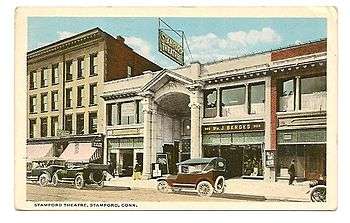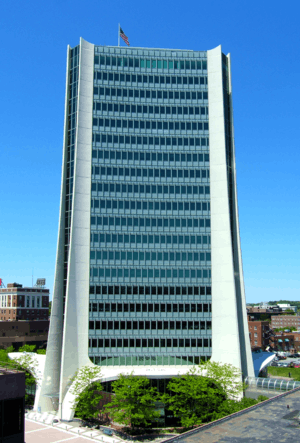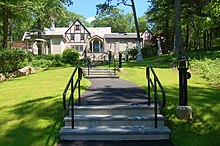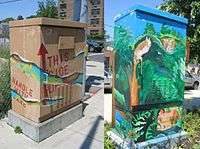Arts and culture in Stamford, Connecticut
In 2017, the City of Stamford established the Stamford Arts and Culture Commission to help bolster arts and tourism in the city.[1]
Theatre and film

Starting in the 1870s a theater operated from the third floor of the old Town Hall until the building was burned down in 1904. Edwin Booth, a Cos Cob, Connecticut resident, is said to have acted in that theater. The nearby Grand Opera House, which stood on the site of the Palace Theatre, also burned down.
The Alhambra Theatre on the present Washington Boulevard, later sprang up and was running as early as 1909. It provided "High Class Vaudeville" without swearing or dirty jokes. In 1914, Emily Wakeman Hartley founded the Stamford Theatre at the corner of what is now Atlantic Street and Tresser Boulevard, where the Rich Forum stands today. Wakeman became manager of the theater, which hosted many famous performers of the day, often before their fame crested. In 1924, Humphrey Bogart trod the boards in a supporting role of a comedy, Fool's Gold. In 1927, Bela Lugosi starred in Dracula: The Vampire Play four years before he played the same role on film. George Gershwin's first Broadway show, La La Lucille played in the theater in 1919, and in 1921, the Al Jolson-produced play, Lei Aloha opened at the theater, six years before Jolson created a sensation with his role in the movie The Jazz Singer. In 1928, the theater advertised a Sunday performance of the "World's Greatest Pianist", Sergei Rachmaninoff, calling him simply "Rachmaninoff".[2]
Current theatre and film venues
- Stamford Center for the Arts: The Palace Theatre, originally opened as a vaudeville house in 1927 and gradually fell into disrepair and disuse, reopened as a restored, nonprofit theater in 1983. It was joined in 1992 by the Rich Forum, another downtown venue. Both have been run by the Stamford Center for the Arts. In 2005 the Palace Theatre completed a major renovation. With the depth doubled behind the stage to about 40 feet (12 m), the 1,600-seat theater can now present more technically ambitious productions such as full-fledged Broadway musicals.[3]
- Rich Forum: Built in 1992, the Rich Forum has served as a pre-Broadway house for numerous shows including Voices in the Dark[4], Fortune's Fool, and More to Love[5]. Since 2009, the Rich Forum has served as the studio for The Jerry Springer Show, Maury, and The Steve Wilkos Show, among other NBCUniversal shows.
- Curtain Call Inc. presents plays and other entertainment at the Sterling Farms Theatre Complex, 1349 Newfield Ave. Its venues and types of entertainment there include the Kweskin Theatre, and Shakespeare in the Park.
- Avon Theatre Film Center, a nonprofit movie house focusing on classic, alternative and art films, opened in the former Avon Theatre on Bedford Street in 2004.
- Bowtie Theatres has two movie houses in Stamford with a total of 15 movie screens: the Landmark and the Majestic.
- In Springdale, the two-screen State Cinema, run by Garden Homes Cinemas of Stamford, has second-run films.
- Mill River Park and Commons Park in Harbor Point both have summer "Movies in the Park" lineups
Music and dance
- Stamford Symphony Orchestra In a typical season, the SSO gives five pairs of classical concerts and three pops concerts at the 1,586-seat Palace Theatre, as well as a concert for elementary school students and a family concert series. Organized in 1919, the orchestra closed down after World War II when too many of its European musicians returned home. In 1967 the orchestra was revived and became fully professional by 1974, when Skitch Henderson was appointed music director. Henderson's reign was interrupted in January 1975 by a prison sentence for tax evasion. The current music director is Eckart Preu, appointed in June 2005.
- Connecticut Grand Opera, a not-for-profit, professional opera company founded in 1993, with offices at 15 Bank Street and performances at the Palace Theatre. On its web site, the CGO claims to offer "the most ambitious opera season of any company between New York and Boston."
- Connecticut Ballet is the state's professional ballet company. The company's artistic mission is the presentation of the highest quality professional classical and contemporary ballet. The company frequently performs at the Palace Theatre, and is known for their annual holiday performance of The Nutcracker.
- Alive@Five Summer Concert Series Since 1997, Stamford Downtown has run the Alive@Five Summer Concert Series that brings thousands of music lovers into the downtown restaurant and bar district. One of the city's largest annual events, Alive@Five has featured legendary musicians such as Boyz II Men, Gavin DeGraw, Andy Grammer, Sean Kingston, Sugar Ray, CeeLo Green, Foreigner, Shaggy, Third Eye Blind, Rachel Platten, ABBA, The Beach Boys and The B-52s to name a few.
Distinctive architecture
- One Landmark Square - Completed in 1973, the Victor Bisharat designed tower was the tallest building between New York and Boston from 1973 until 2010. It is one of the most recognizable buildings in Stamford, and has been compared to both the TWA Flight Center and the Cathedral of Brasilia.[6]
 One Landmark Square, one of Stamford's most distinctive buildings
One Landmark Square, one of Stamford's most distinctive buildings - Fish Church -The First Presbyterian Church of Stamford, is a church in Stamford, Connecticut designed by architect Wallace K. Harrison. Nicknamed Fish Church, for its unusual shape, it is a unique example of modernist architecture, and an architectural landmark. Its 260-foot-tall (79 m) Maguire Memorial Tower holds a 56-bell carillon.
- St. Mary Roman Catholic Church - Completed in 1928 on Elm Street is modeled on a Gothic church in Europe and is the largest house of worship in Fairfield County.[7]
- 1 High Ridge Park - Completed in the late 1960s, the building looks like a fortress, complete with a moat (previously filled with water, it is now dry). Bridges lead to its entrances. It was built for CBS Research a company worried about its security. Originally the building had few or no windows facing outward and tenants saw the sunlight through atriums and skylights. In the 1970s, after CBS Research left, slit-like window areas were put in the outside walls, letting in some light.
- 2 High Ridge Park - The saucer-like building was meant to recall clocks and watches. The building was originally built for General Time, a large clock manufacturer. It has been compared to a flying saucer, a concrete bowl, and a clock.
Science and nature
In the 20th century, particularly after World War II, educational and cultural institutions were founded in the city or expanded in a range of areas.
- From its founding in 1936 until 1945, the Stamford Museum & Nature Center (then known as "The Stamford Museum") was in a few rented rooms downtown. It set up the first small planetarium between New York and Boston in 1941, when it had a 6-inch (wide) telescope and a dome made of wood slats and cardboard. In the 1950s the museum had to move again when Interstate 95 was built, and it went to a 118-acre (0.48 km2) site in the northern end of town. It has a collection of works by Gutzon Borglum, the sculptor of Mount Rushmore, who was a Stamford resident for a decade.
 Bendel Mansion at the Stamford Museum & Nature Center
Bendel Mansion at the Stamford Museum & Nature Center- The nature center's farm includes llamas, pigs and sheep. In early 2007, more than seven lambs were born at the farm, as well as some piglets. The sheep are mixtures of Jacob, Dorset and Black Welsh Mountain sheep breeds.[8]
- The Fairfield County Astronomy Society was started up in 1956 and ran the new Stamford Observatory. A 20-inch (510 mm) telescope, made with donated materials from numerous businesses, most notably the Perkin-Elmer Corporation (then headquartered in Norwalk) was dedicated on June 13, 1965. Since the relatively large telescope went into operation the astronomy club has conducted research and for a time became the home of the Journal of the American Association of Variable Star Observers.
- Bartlett Arboretum and Gardens. In November 1965 the state of Connecticut bought the 64-acre (260,000 m2) estate of Dr. Francis A. Bartlett, a dendrologist who had planted the site with tree and bush specimens from all over the world. The Arboretum opened to the public for the first time in 1966 and was transferred to the City of Stamford in 2001. Today the Bartlett Arboretum Association runs the institution, and an additional 27 acres (110,000 m2) have been added to the site, giving it a total of 91 acres (370,000 m2).
- SoundWaters Community Center for Environmental Education is located in Cove Island Park.
Visual arts
Stamford has many opportunities to see wonderful pieces of art by both local artists as well as national and international ones.
- Loft Artists Association has been home to many local artists since 1978. Located in the once abandoned 100-year-old factory of the former Yale & Towne Lock company in the city's South End, the association is home to many painters, sculptors, photographers and crafts people. They have regular showings and open houses throughout the year. They recently moved to another location in the South End when the factory building was bought by developers.
- Stamford Art Association was begun in 1971. It is a non-profit organization that showcases local artists to the public. It currently is downtown on Franklin St. close to the UConn-Stamford Campus.
- Stamford Downtown Special Services District holds the annual "Art in Public Spaces" display every summer from June to August. Based on the Cow Parade, of which Stamford participated in 2000, artists from all over the world are commissioned to create pieces of art while staying within the theme of the year. When the exhibit is over, the pieces are usually put up for auction with the proceeds going to various charities. Often you can see many of the pieces on display years after their respective exhibits in front of businesses or in the lobbies of many of the corporate buildings.
- Frankin Street Works is an award-winning, not-for-profit contemporary art space and café that creates original museum-quality exhibitions and engaging educational programs. The organization’s goals include broadening community participation in the arts, contributing to a larger arts dialogue, and cultivating emerging artists. They have received two prestigious multi-year grants from the Andy Warhol Foundation for the Visual Arts.
- Fernando Luis Alvarez Gallery Alvarez Gallery has been growing emerging and important contemporary artists' careers since opening in 2009. Together with their artists, the Gallery uses the power of the arts to build programs and initiatives that enlighten and enliven the community. They are not focused on finding the stars of tomorrow, but rather finding artists that help build-up the community.
- Ukrainian Museum & Library is the oldest cultural institution established by Ukrainians in North America. It is dedicated to the collection, documentation, preservation and exhibition of artifacts and publications dealing with Ukrainian culture and heritage. By making its resources available for study and research, it is instrumental in the dissemination and advancement of knowledge about Ukraine and the Ukrainian ethnic community in the United States.
- Hoyt-Barnum House Museum is a historic house museum that was listed to the U.S National Register of Historic Places in 1969. The house was originally built in 1699 by Samuel Hait (or Hoyt), this is the oldest authentic residence in Stamford. The house contains artifacts from the 18th and 19th centuries, as well as reproduction items that you can touch. The house was relocated from Downtown Stamford to its current home, next to the Stamford History Center, in November of 2016 to increase its accessibility to the public.[9]

- Stamford Museum & Nature Center aside from being a nature center, also houses an art gallery in the Bendel Mansion, the museum's main building. Aside from the art on display in the museum, the Bendel Mansion itself is a work of art. Built in the 1920s by Henri Willis Bendel and designed by Perry Barker, the house and surrounding grounds are based on classical English manor houses, with Italian marble statues along the walkways through the gardens. The house is one of the prime examples of the "American Castle" which became famous during the time period.
- Throughout various parts of the city, electrical boxes are painted as a beautification of the city. There are 190 large dull grey electrical boxes which sit on street corners all over town. In 1993, the Springdale Neighborhood Association commissioned a local artist to paint the boxes in the section of town to "brighten" up the eyesores. The trend caught on and now over 100 boxes have been painted by various painters and artists through much of the city.
References
- "Arts and Culture Commission | Stamford CT". www.stamfordct.gov. Retrieved 2018-10-05.
- Parry, Wynne, "Vaudeville and Beyond: Before the heyday of movies and television, stages offered a cavalcade of acts", article, The Advocate of Stamford, Connecticut, December 24, 2007, pp 1, A4, Norwalk and Stamford editions
- Dunlap, David W., "Stamford Reinvents Its Downtown Once Again" New York Times, January 5, 1997
- League, The Broadway. "Voices in the Dark – Broadway Play – Original | IBDB". www.ibdb.com. Retrieved 2018-10-05.
- League, The Broadway. "More to Love – Broadway Play – Original | IBDB". www.ibdb.com. Retrieved 2018-10-05.
- "Urban Renewal | F. D. Rich Company". fdrich.com. Retrieved 2018-10-05.
- Fenwick, Alexandria, "Centennial Milestone: St. Mary Roman Catholic Church marks 100 years of faith, tradition, fond memories," article in The Advocate of Stamford, Saturday, August 12, 2006, page A12
- Damast, Alison, "Are EWE my mother? Lambs are first spring arrival", article in The Advocate of Stamford (Stamford and Norwalk editions), page 1
- "Visit a Stamford Home built in 1699". stamfordhistory.org. Retrieved 2018-10-05.